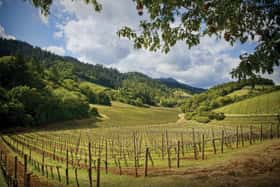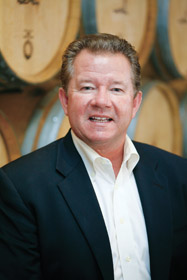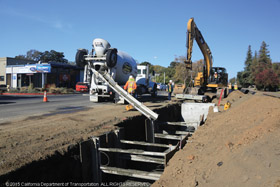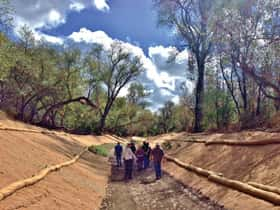
The county comes together in rebuilding, disaster relief, ongoing success and progress.
After the initial panic, excitement, sirens and headlines, the exhilaration of coming together to help others eventually fades, and the people on whose turf an emergency occurs are left to the slow process of rebuilding. So it is in the city of Napa in the aftermath of the 2014 South Napa Earthquake.
 “When you’re dealing with a disaster,” says Napa Mayor Jill Techel, “things are happening very quickly. You have a lot of aid; you have a lot of people helping. When it’s over and you have to rebuild and recover the costs, there’s a lot of paperwork, a lot of background work and a lot of details and data that have to be gathered. There are books of material and information you have to put together to access FEMA (Federal Emergency Management Agency) funds and move forward. That isn’t always the piece we hear about.”
“When you’re dealing with a disaster,” says Napa Mayor Jill Techel, “things are happening very quickly. You have a lot of aid; you have a lot of people helping. When it’s over and you have to rebuild and recover the costs, there’s a lot of paperwork, a lot of background work and a lot of details and data that have to be gathered. There are books of material and information you have to put together to access FEMA (Federal Emergency Management Agency) funds and move forward. That isn’t always the piece we hear about.”
Nor is it the fun part, but it’s an added piece of work, along with normal operations, that Napa officials and employees are dealing with as recovery continues to move forward.
The post office building in Napa has been listed for sale, as the repairs will exceed the funds available to the US Postal Service. “We’re not sure who’ll be interested in buying,” says Techel, “but it’s a positive step. We wish we could repair it, but that’s not an option.”
Techel says she’s pleased that, after the quake, property values didn’t go down, and people are still interested in investing in downtown Napa. “This is a very unique and wonderful business opportunity, right in the center of Napa,” she says.
Other buildings are being repaired as well. The Alexander Square building is done and Carpe Diem Wine Bar is opened again. The Goodman Library and Historical Society now has a contract for its first phase of repair: putting a cage over the parapet on the top so engineers can more accurately determine what the next step will be. “That work is expected to be done in the spring,” the mayor says, adding that, “we’re getting very good at knowing how to secure buildings.”
An example of the difficulties that can arise include the length of time it took to raise the estimated $167,000 necessary to stabilize Napa Self Storage so renters could retrieve their possessions. Techel explains that FEMA declined to support the recovery, as the structure wasn’t a dwelling. Instead, over the course of the year, enough money was accumulated through contributions from unit tenants, the Community Relief Fund and the self-storage company itself, so unit renters will now be able to retrieve their belongings.
“You just have to understand that there are steps,” says Techel, “and to ensure no one can cheat them, FEMA has a lot of rules and regulations. It’s very cumbersome, but the alternative is to not have them—and that would be much worse.”
Visitors unfazed
“Tourism is doing remarkably well since the earthquake,” says Clay Gregory, president and CEO of Visit  Napa Valley. “The year it happened, [tourism numbers] were down in August and September, about even in October and in November. Then, starting in December, we were up double digits. We continued through May in double digits in total lodging revenue, which is really remarkable. In June, it was still up by 9.3 percent over the previous year. Then back up in July and August, which is just phenomenal. And that’s against 2013 and 2014, which were good years. We couldn’t be any happier, really.”
Napa Valley. “The year it happened, [tourism numbers] were down in August and September, about even in October and in November. Then, starting in December, we were up double digits. We continued through May in double digits in total lodging revenue, which is really remarkable. In June, it was still up by 9.3 percent over the previous year. Then back up in July and August, which is just phenomenal. And that’s against 2013 and 2014, which were good years. We couldn’t be any happier, really.”
As to what’s driving the success, Gregory points to several factors: the good work done after the earthquake by Visit Napa Valley, Napa Valley Vintners and the city of Napa, working together with US Travel, Visit California and San Francisco Travel to get the message out that Napa Valley was alive and well. “So we were able, as a team, to change the message from ‘Disaster!’ to ‘Open for Business!’” says Gregory.
Adding to that successful marketing effort was harsh weather and lack of snow in other destinations, which drove people to sunnier climes such as Napa Valley for winter vacations. Last but not least, he gives credit to the new website, www.VisitNapaValley.com, which now gets more than one million visitors per year.
Problems with the housing boom
Napa is booming, but housing is tight. According to Larry Florin, director of housing and intergovernmental affairs for Napa County, the demand for housing in Napa has dramatically increased, with multiple offers for every house that’s come on the market since the beginning of 2015. “We’re hearing anecdotal reports of four, five, six offers on everything that comes available,” he says.
Property availability for sale in what realtors call the mid-range—$500,000 to $800,000—is tight. “Interestingly,” he says, “in the more than $1.5 million range, it’s not so tight. There’s a lot of competition. It’s the middle-income group that’s being the most affected right now.” It has gotten worse.
“I don’t think we have many starter homes in the county,” says Karen Cherniss, real estate specialist for Pacific Union International Real Estate Agency. “After the downturn in 2009, investors swarmed in to buy up the bank-owned or foreclosed properties, fixed them up and ‘flipped them’ at a profit.” As result, most of the original owners and many first-time buyers have been priced out of the market.
“Vacancy rates for rental housing are incredibly low,” says Larry Florin. “The rate is 1.5 percent, which is really like zero percent. When rentals do come on the market, they’re expensive: A two-bedroom apartment will run in the range of $1,500 to $2,500 per month. A three-bedroom house will be in the $2,500 to $3,500 range.
With housing so tight, the debate over vacation rentals—homeowners letting out rooms or entire houses to tourists for 30 days or fewer—sharpens. Homeowners argue it’s their right to let their rooms or houses typically at higher rates than long-term rentals to visitors for extra, sometimes much-needed cash. Neighbors object to the impact on communities, including increased noise and traffic, and an “emptying out” of a sense of community (See “Do Unto Others,” October 2015.)
One impact of converting extra space to vacation rentals instead of long-term rentals is that it closes off an opportunity for people who commute to work in cities like St. Helena and Napa to be able to find places to live close to their jobs.
Getting from here to there
A Napa County Transportation Authority traffic study released in 2014 showed that, contrary to the idea that excess traffic is a product of tourists visiting wineries, the smallest percentage of congestion was due to visitor traffic. Instead, the majority of traffic up and down the valley consists of daily in-bound and out-bound commuter traffic and traffic within towns. So when crawling along Route 29 and looking for someone to blame, one might start with a look in the rear-view mirror. But are there any solutions?
“Cracking down on wineries isn’t the whole answer to traffic issues,” says District Three Supervisor Diane Dillon, who’s a St. Helena resident. “Some wineries have moved their offices into Napa and corporate areas, where space is more affordable and available,” she says. “So we’ve taken a lot of people [who may live in Napa or Solano counties] off Route 29. Should we be encouraging that? Incentivizing that?”
Another idea she hears batted around is establishing some kind of shuttle system to get visitors to wineries. “But how would that be funded? And would it do much good if it were just for visitors and not workers?”
The obvious solution to the commuter traffic problem would be to have workers live closer to their jobs. But that seems a dream from another time.
“The reality is, we would like people who work here to be able to live here,” says District One Supervisor Brad Wagonknecht, “but this isn’t just a matter of houses being available.” He acknowledges that since most hospitality and agricultural jobs are on the lower end of the pay scale and most Napa County housing is priced on the upper end, many workers simply aren’t going to be able to live near their work.
“We’re doing as much as we can to make housing affordable and to make the jobs higher paid,” he says. But it’s getting more and more difficult to produce affordable housing, he confesses, noting that, in St. Helena, for example, “many houses are second homes or weekend homes. Vacation rentals, where allowed, also take housing out of circulation for locals.”
The resulting community (or lack thereof) is hard on local merchants, who lose their regular customers, and for remaining residents, who mourn the loos of their cozy small town into something more impersonal.
Fix the problems you can fix
 The roadwork on Route 29 into St. Helena will be completed in 2017, which seems a long time from now—and a long time to endure construction on that major roadway through the valley. But when it’s done, what Caltrans calls the “Route 29 channelization” will go a long way toward keeping traffic flowing between Mee Lane and Charter Oak Avenue, while still letting people access wineries.
The roadwork on Route 29 into St. Helena will be completed in 2017, which seems a long time from now—and a long time to endure construction on that major roadway through the valley. But when it’s done, what Caltrans calls the “Route 29 channelization” will go a long way toward keeping traffic flowing between Mee Lane and Charter Oak Avenue, while still letting people access wineries.
The channelization project involves constructing a central turn lane (for those who need to cross traffic to enter a winery or even just make a left turn) that will make the trip north into St. Helena seem like an actual possibility during midday rush hour. “It’s been in the planning stages for a long time,” says Vince Jacala, Caltrans public information officer. “A lot that’s been going on, so far, is preliminary—AT&T and PG&E have been installing the underground utility lines. Now we’re heading into the meat of the project, the road construction.”
Caltrans will be much more involved in the next couple of months as it begins the dirt work and paving, which will widen the highway. He explains that, if and when the rain comes, Caltrans will have to shut down work because it can’t pave in wet weather. Nor can crews pave when it’s colder than 40 degrees. “So if it really rains a lot, we’ll have to move it back a season.”
What isn’t finished by November 2015 will have to be put off until spring. When it’s done, the channelization will improve access and flow into Wine Country, Jacala says. Caltrans will soon start doing a lot of the work at night. “We’re trying to get to a point where we don’t affect businesses and daily traffic as much.”
Dillon is looking forward to the improvement as more than just a traffic flow solution. “It’s primarily a safety issue,” she says. “Right now, it’s almost impossible for fire trucks, ambulances, sheriffs or police to get through easily when traffic is heavy.”
issue,” she says. “Right now, it’s almost impossible for fire trucks, ambulances, sheriffs or police to get through easily when traffic is heavy.”
An added benefit is that, to create the widened lanes, many utility wires had to be buried underground. “I have people all the time telling me how the entrance to St. Helena is so much nicer than it used to be [now that all the utility poles are gone], and how the whole vista opened up so we can see Mt. St. Helena as we drive up Route 29, which is as it should be,” she says
Another bonus is that having utilities underground will save on repairs. All of this is good, but there’s more to be done, she cautions. “Our staff has done a really good job trying to get funds allocated to repave roads in St. Helena, particularly Silverado Trail, as it’s a major corridor. In 2018, the transportation tax will kick in and we really look forward to doing many more road improvements.”
Napa River restoration and renewal
“We’ve done some great work on the river,” says Wagenknecht. “We’re getting closer to the end of the project. We’ve completed one big section of reclamation—the Rutherford Dust section—and now we’re on to the Oak Knoll Reach. When it’s all complete, it’ll be about 15 miles in the middle of the valley. We need to look for future funding: we used Measure A funding and matched that with state and federal funding [for the previous work].” Measure A was a temporary, 20-year flood tax. Additional funding comes from water and park bonds. The county voted for flood control in 1998, and Measure A runs out in 2018, when it changes from a flood tax to a road tax. The project, funded by landowners, the local Napa community and state and federal grant programs, is in the design stage and construction could continue through 2019.
“It’s going to be wonderful when it’s done,” he says enthusiastically. “What we’ve successfully done is beautiful.” Wagenknecht says he’s impressed with the way nature has taken hold of the project. “Honig Vineyard and Winery has an area that’s been reclaimed and renovated, and it’s made the river much more beautiful. It’s doing for the river what the river would do for itself [if it could]. Giving land back to the river thoughtfully is better than trying to fight with it.”
Downstream near the mouth of the river in the city of Napa, the Napa River Flood Project allows for a living river and lovely flood plain that protects and transforms the area. By utilizing a suite of innovative green engineering practices and traditional hard grey infrastructure to address the constant threat of devastating floods, a glorious waterfront landscape has emerged that’s part urban park, part event center and part retail and restaurant promenade.
“It’s amazing to have gotten to this place in the flood project,” says Mayor Techel. “The bypass will channel away 50 percent of water during heavy storms instead of flooding the town.” Facing the prospect of an El Niño winter, this is a timely achievement. “It makes me sleep better at night knowing we’ve completed this part of the project and that it will be functional this winter,” she says.
 More immediately, what’s happened is a transformation of the waterfront into a wonderful community space: You can now walk on the path from behind the Oxbow Public Market, into the bypass, come up to the Opera House and stroll on into downtown Napa, effectively crossing the river without taking a bridge.
More immediately, what’s happened is a transformation of the waterfront into a wonderful community space: You can now walk on the path from behind the Oxbow Public Market, into the bypass, come up to the Opera House and stroll on into downtown Napa, effectively crossing the river without taking a bridge.
The terraced area that’s become Oxbow Commons Park is wide-open and inviting. “We’re just thinking about how to use it as an event space,” says Techel. “A lot of things that now are on Veteran’s Park could easily be done in the bypass—art exhibits, those kinds of things. We’re excited by the beauty of it, the connectivity of it and the use of it as shared event space for Napa.”
This is a dream come true for many who worked hard for a project that would honor the way of the river, protect the interests of the town and provide pleasure for all who live in and travel through. The project’s success serves as an example of the ability of Napa residents to meet challenges creatively, with a vision that embraces all that’s special about this place.
David Duncan, chair of Napa Valley Vintners, sums up the sentiment you’ll hear in almost any conversation about Napa: “This is a special place. We’re all committed to take care of it and we’re all incredibly fortunate to be here.”
Too much success?
Beautiful agricultural landscapes and winery tasting rooms, the two biggest Napa Valley tourist draws, seem at odds with groups such as Vision 2050 coalition, which was formed in 2015 to prevent development, particularly of wineries. The worry among some county residents was that some wineries could, because of their excessive size, number of activities or central location, lead to environmental degradation, such as water depletion, or traffic that would generally compromise the quality of life in the valley.
This past year, looking into the matter from the point of view of winery permit compliance and how that could affect the integrity of the Ag Preserve, the board of supervisors formed the Agriculture Protection Advisory Committee (APAC). Led by Ted Hall, owner of Long Meadow Ranch and a director of the Napa Valley Grape Growers, the group set out to hear from various stakeholder groups and come to an agreement on a set of recommendations for the board. (See “All That’s Allowed,” December 2015.)
“The best thing that came out of it,” says NVV’s Duncan, “is that many different voices were heard in a democratic setting. We, as a group, were able to open up and listen to the people against winery development and learn what their concerns are. I’m in favor, personally, of the county enforcing its rules. It has good rules—they’ve just been loosely enforced. Enforcement and sticking to the general plan is going to be a good thing for the valley as we go forward.”
“We want people to come in [voluntarily if they’re not in compliance with their use permits],” says District Two Supervisor Mark Luce. “We don’t want to go to code enforcement. We want a system for people who should be permitted to come in and go through the process.” This doesn’t mean everything will be permitted, he clarifies. “It’s not a free ride. It’s a permit process. But we have to make it friendly, so [winery owners are] willing to go through it. I think we can be business friendly and agriculture-protective. I don’t think they’re mutually exclusive.”
“I understand we’ve gone through substantial changes in terms of how wineries are doing business,” says Dillon, “and you can’t just say, ‘For 25 years, we’ve been telling people that, if you find yourself out of compliance with your use permit, come in and apply for a modification so that you are compliant.’ And now, people want us to just tell these wineries, ‘No, you have to stick to your use permit. You have to go back to it now.’
“You just can’t do a fast 180 on people. We need to be thinking about the unintended consequences and find a path that’s fair to everyone.”
An indirect benefit of compliance, Dillon suggests, is that, when people are fuming about traffic, they’d feel better if they felt wineries were in compliance with their permits. “I think people would feel somewhat better if they didn’t think the wineries were taking advantage.”
What draws them to Napa?
It’s always interesting to review visitor surveys and see top reasons for visiting Napa Valley. The most recent survey, like those conducted in 2005 and 2012, continues to show the number one reason people come here is the natural beauty, followed closely by the wine. “It’s always neck-and-neck between the two,” says Gregory. Lucky thing, here in Napa Valley, there are copious amounts of both, and it’s fair to suggest that the combination is the magic that keeps people coming back.
“We’re big supporters of the Ag Preserve,” says Gregory. “It’s what’s kept the valley as beautiful as it is.” From a visitor’s point of view, all is working well. “The cool part,” Gregory continues, “is that in the visitor profile study, when people were asked what brought them to Napa Valley, they typically said the beauty and the wine. Then, when they were asked, what could make the experience better, the vast majority wrote out, ‘Nothing, it’s perfect.’” (The only issue that came up—fewer than 5 percent of responders—was traffic.)
The wine industry thrives and shares
Napa Valley Vintners’ annual Auction Napa Valley succeeded again this year with $15.8 million raised to benefit the community. “We were thrilled,” says Duncan. “I think we’ve done away with the idea that you have to do more every year—I don’t think we could present a better auction. We helped more than 100,000 people through Napa County nonprofits in 2014. That’s an incredible thing to be able to do.”
Proceeds from the auction benefit the whole of Napa County, with grants going to the Napa Valley Relief Fund (started in 2014 to help with the earthquake) as well as to support health, early childhood education and services for families, seniors, parents and young students who deserve a chance. Over the last 30 years, NVV has given $145,000 to the community through select nonprofit groups.
Fund (started in 2014 to help with the earthquake) as well as to support health, early childhood education and services for families, seniors, parents and young students who deserve a chance. Over the last 30 years, NVV has given $145,000 to the community through select nonprofit groups.
This year, the Valley Fire flared up right after the auction, so, “We made an initial grant of $250,000 almost immediately for Lake County fire victims through the UpValley Family Center,” Duncan says. With locations in Calistoga and St. Helena, UpValley provides education, health care, tax preparation, counseling and child care programs to families in need.
Moving toward sustainability
NVV is now committed to having all its members certified by the Napa Green sustainability program by 2020. Currently, says Duncan, 66,000 vineyard acres are either certified or pending certification. Wineries are getting certified, too. “The production of Napa Green certified wineries increased to more than 5 million cases per year,” he says. “We’re continuing to have seminars and beating the drum to get more people to sign up.”
The incentive? “Staying in the organization after 2020,” he laughs. “Our goal is to make sustainability not something you choose anymore—just something you do. For some, it’s quite a challenge. It’s making them rethink what they do and how they do it.”
As a farmer and vintner, Duncan is committed to the community and the industry. “We’re all incredibly fortunate to be here and to work in this industry, which is a critical part of what Napa County is,” he says. “Napa Valley Vintners is fighting for the same things the community wants, in terms of a great place to live, grow grapes and make wine.”
This is deep and revered tradition. “I appreciate the vision of our forefathers, who gave us the Ag Preserve and the Winery Definition Ordinance,” he says. “I think we’re fortunate that we get to stand on the shoulders of those visionaries, and I can look out my windows and see nothing but vineyards and trees in the background.”
UpValley Takes the Lead
As Lake County residents evacuated in front of the fast-advancing Valley Fire, the Calistoga Fairgrounds quickly filled up with evacuees from Cobb and Middleton, many of whom would have no homes to return to. Suddenly, the UpValley Family Center was tasked with an additional mission for which it was perfectly prepared. “Our expertise is connecting people to resources,” says Executive Director Jenny Ocón. “It’s not typical that we do that in an emergency, but we have people who are bilingual in English and Spanish and knowledgeable in a host of resources.”
With the NVV grant, the center was able to bring on additional temporary staff and set up a table at the fairgrounds to provide immediate help in the form of gas cards, clothing and help with a first month’s rent deposit if people were able to find a place to live.
“We were getting inundated with calls from people who needed help, people who wanted to help and people looking for loved ones,” says Ocón. Now that the fires are out, the emergency for residents who’ve lost homes isn’t over. She says she recently went to Lake County to see how the community was faring and to make sure that, as the community begins to rebuild, the center maintains good channels of communication with those who need assistance. “It’s a lot of work and our staff put in a lot of extra hours, but we were a critical resource,” she says. “I’m really proud about how we worked together and how the community came together. So many people volunteered.”
Education: Progress and Hope
“The most public way we measure progress is the Common Core,” says Patrick Sweeney, Superintendent of the Napa Valley School District (NVUSD). The Common Core State Standards were established to create consistent educational standards across the United States. “But,” he adds “I think we have to be thoughtful in how we measure students and not just depend on one standard.”
One critical measure for how students in Napa County are doing on a daily basis is whether they’re actually present and engaged. In Napa County the attendance rate is 95 percent, well above state average; the expulsion rate less than one percent; students scored at 99th percentile in feeling safe; and the NVUSD suspension rate is 4.5 percent.
Other measures include seeing students demonstrate critical thinking, communication, collaboration and creativity, all qualities that will be needed in the 21st century workplace. Another measure is academic achievement, ensuring students take the classes and have all the credits required to attend schools in the UC system.
The county is working to help all students to be prepared for college and career. To help English learners, the NVUSD offers tutoring, parent education and adult education programs, with the result that each year, according to Sweeney, “We reclassify about 15 percent of our English Language Learners as ‘Proficient in English.’”
“We’re committed to developing confident and compassionate citizens who’ll transform their lives and contribute to our community,” he says.
In the Midst of Plenty
“We’ve really worked on Live Healthy Napa County,” says Third District Supervisor Brad Wagenknecht, of the private-public initiative that began in 2012 to improve the health of Napa County residents. “It used to be health was between you and your doctor,” he says. “Now, we’re looking at doctors as just a part of health awareness. You’re the captain of your health, not your doctor.”
So far, LHNC has created three sets of initiatives, a Community Health Assessment, in 2013, a Community Health Improvement Plan for 2014 to 2017 and a 2015 to 2020 Obesity Prevention Plan. It’s working hard now on the obesity prevention plan.
“Obesity is a big health issue in Napa County,” says Dr. Karen Relucio, Napa County director of public health. “So we have an obesity strategy team called the Healthy Bodies Coalition. Its goal has been to help prevent obesity by not just education but making available options for healthy food and physical activity. Sometimes, all it takes is making these healthy choices more readily available. For example, we have lot of childhood obesity, and some schools have started growing gardens,” she says. “When children understand where their food is coming from it helps make healthy choices more acceptable.”
Physical activity is another important part of combating obesity. “People who live in an area of poverty don’t have as easy access to parks and recreation,” says Relucio “So trying to make that available in poorer neighborhoods is an important strategy.
Poverty is a recognized indicator of health, and Napa County isn’t free of its impact. “We have the reputation of having a lot of very wealthy people living in the county,” says Relucio, “but there are definitely health disparities. There are certain neighborhoods, only four or five miles apart, where the life expectancy may vary by 10 years.”
There are many challenges, not the least of which is prioritizing. “Right now, there are so many strategies and proposed actions that it’s hard to keep track. So we’re trying to focus on certain strategies so we can measure the outcomes.” LHNC is starting with obesity and then will proceed to poverty, behavioral health and senior issues. “The population of Napa County can be healthier,” she says, “but it’s a long-term process.”
It’s been a very good year
 Despite the ongoing drought, Napa County Agriculture Commissioner Dave Clark says we’ve been fortunate in the last couple of years to have had sufficient rain that produced a good quality crop. However, “Crop yields are down,” he says, “depending on the location.” This year was no different.
Despite the ongoing drought, Napa County Agriculture Commissioner Dave Clark says we’ve been fortunate in the last couple of years to have had sufficient rain that produced a good quality crop. However, “Crop yields are down,” he says, “depending on the location.” This year was no different.
Pests are at the moment under control. The European Grapevine Moth, which has been a concern, as it causes real damage to crops, is all but eradicated. “Last year the quarantined areas were reduced to a little bit in Sonoma County and a portion of Napa County,” he says. “So if we project a year out, we hope the quarantine will be lifted and we will depend this pest is eradicated.”
Not so with the infamous Light Brown Apple Moth (LBAM), which arrived on the scene from the Monterey area in 2008 preceded by a reputation as a “voracious” pest that would feed on anything and could drive California agriculture into ruin if it took hold. The USDA ordered quarantines of vineyards within a mile and a half from where a moth was found. A campaign of pheromone deterrents delivered on twist ties were applied to trees and bushes in and near affected areas. Now, the LBAM, having created little or no damage, lives on. “Despite everyone’s best efforts, he appears here to stay,” says Clark. “Nobody has eradicated it. It’s making its way to different parts and into Central Valley.”
The pest most feared, for good reason, is the glassy winged sharpshooter, which remains at large and  shows up occasionally on plant shipments from other areas. Some were found recently in shipments from Marin County. “We have staff that, on a daily basis, inspect nursery shipments,” says Clark. “We have good partners with Marin and Sonoma agriculture commissioners, and we all see the glassy winged sharpshooter as a threat to the region with the potential to impact not just grapes but the environment as well.”
shows up occasionally on plant shipments from other areas. Some were found recently in shipments from Marin County. “We have staff that, on a daily basis, inspect nursery shipments,” says Clark. “We have good partners with Marin and Sonoma agriculture commissioners, and we all see the glassy winged sharpshooter as a threat to the region with the potential to impact not just grapes but the environment as well.”
The reason is that, unlike LBAM and the European grapevine moth, which do their damage by munching on leaves or fruit, the sharpshooter carries Pierce’s disease, a highly contagious disease that kills grapevines–a much more serious problem. The solution is vigilance and so far, that’s working.
Napa real estate values high and rising
The Paragon Real Estate Group reports there’s a current boom in housing demand and. prices have risen significantly over the last three years. In Napa, the median house price is $612,000 (in 2012, the median house price was $342,000). The median home prices continue to rise, but are still well below the peak that preceded the collapse of 2006-2007.
Houses in Napa County have appreciated so that a house purchased in 1990 for below $200,000 would be valued at just under $600,000 today.
Market value per square foot is highest in St. Helena, with properties in that city valued at $622 per square foot (the city of Napa sits at $377 per square foot).
For luxury homes–those priced above $1.1 million–the highest priced home was sold in Yountville, at $10,923,000, followed by Oakville, ($7,250,000) St Helena, ($6,450,000) and Napa, ($4,250,000).
Read the full report at: http://www.paragon-re.com/Marin_Napa_Sonoma_Real_Estate_Market_Report/



